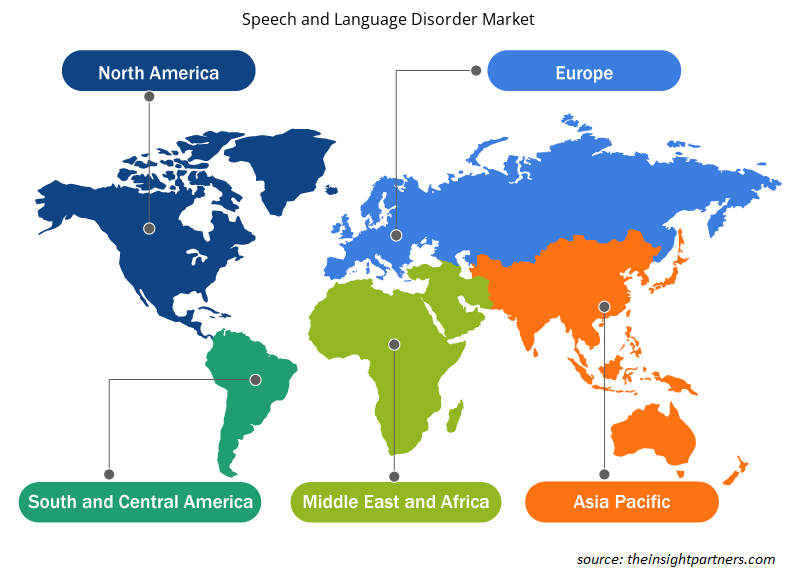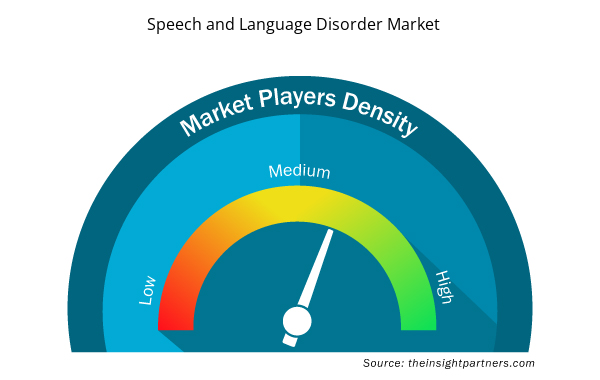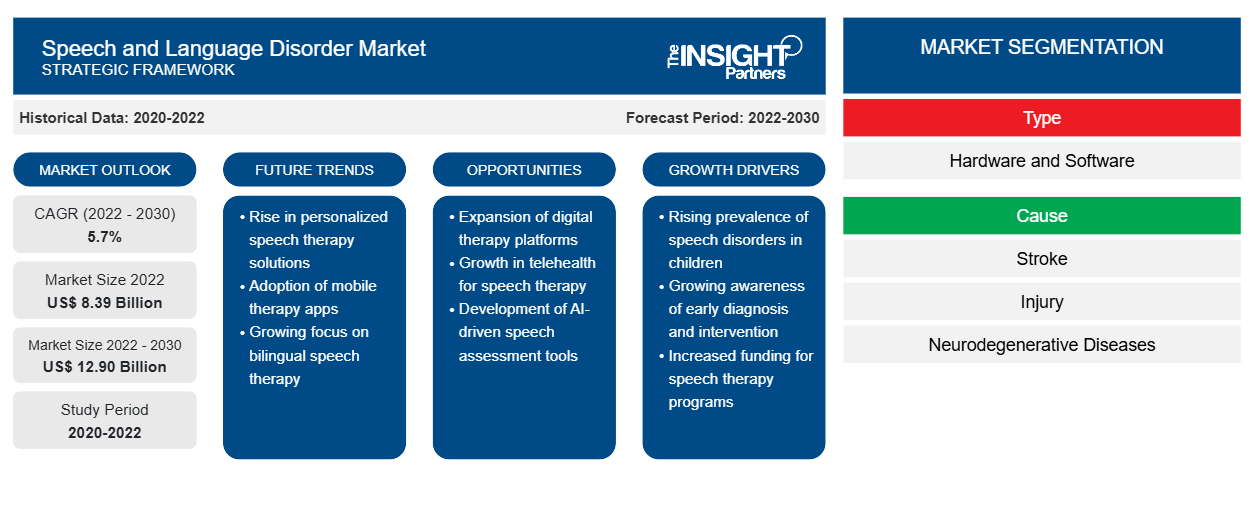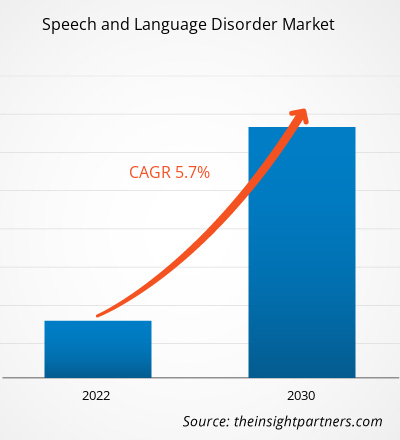[Rapporto di ricerca] Si prevede che il mercato dei disturbi del linguaggio e della parola raggiungerà i 12,90 miliardi di dollari entro il 2030, rispetto agli 8,39 miliardi di dollari del 2022. Si prevede che registrerà un CAGR del 5,7% nel 2022-2030.
Approfondimenti di mercato e opinioni degli analisti:
Il disturbo del linguaggio è una condizione in cui il paziente ha un problema nel formare o creare particolari suoni del linguaggio necessari per comunicare facilmente con gli altri. Mentre, nel disturbo del linguaggio, la persona non riesce a comprendere il messaggio o il significato che l'altra persona sta cercando di trasmettere o ha difficoltà a esprimere correttamente il proprio pensiero. I disturbi del linguaggio e della parola possono talvolta verificarsi a causa di disturbi comportamentali o emotivi. Sebbene questi disturbi vengano affrontati con varie terapie nelle parti sviluppate del mondo, c'è una significativa carenza di professionisti sanitari nelle aree sottosviluppate o remote, il che sta ostacolando la crescita del mercato dei disturbi del linguaggio e della parola.
Fattori di crescita e sfide:
La crescente prevalenza di disturbi del linguaggio e della parola e il crescente numero di casi di malattie neurodegenerative e ictus guidano la crescita del mercato dei disturbi del linguaggio e della parola. Secondo i dati pubblicati da The Stuttering Foundation, più di 80 milioni di persone, ovvero l'1% della popolazione mondiale totale, balbettano. Secondo la stessa fonte, circa il 5% di tutti i bambini balbetta per circa 6 mesi o più e circa l'1% di questi bambini balbetta oltre il lasso di tempo medio per un lungo periodo.
Inoltre, secondo il National Institute on Deafness and Other Communication Diseases, la prevalenza di disturbi del suono del linguaggio, come disturbi dell'articolazione e disturbi fonologici, è di circa l'8%-9% nei bambini piccoli e circa il 3,3% del totale dei bambini statunitensi di età compresa tra 3 e 17 anni ha disturbi del linguaggio. Pertanto, la crescente prevalenza di disturbi del linguaggio e della parola, come disturbi dell'articolazione, disturbi fonologici e balbuzie, a livello globale sta guidando la crescita del mercato. Inoltre, si prevede che l'uso dell'intelligenza artificiale per la logopedia e la terapia del linguaggio porterà nuove tendenze di mercato per i disturbi del linguaggio e della parola nei prossimi anni.
Personalizza questo report in base alle tue esigenze
Riceverai la personalizzazione gratuita di qualsiasi report, comprese parti di questo report, o analisi a livello nazionale, pacchetto dati Excel, oltre a usufruire di grandi offerte e sconti per start-up e università
- Scopri le principali tendenze di mercato in questo rapporto.Questo campione GRATUITO includerà analisi di dati che spaziano dalle tendenze di mercato alle stime e alle previsioni.
Segmentazione e ambito del report:
L'analisi del mercato dei disturbi del linguaggio e della parola è stata condotta considerando i seguenti segmenti: tipo, cause, tipo di disturbo, fascia d'età, fornitore e area geografica. In base al tipo, il mercato è suddiviso in hardware e software. Il segmento software è ulteriormente suddiviso in basato sul Web e basato su app. In base alla causa, il mercato è suddiviso in ictus, lesioni, malattie neurodegenerative e altri. Il segmento delle malattie neurodegenerative è ulteriormente suddiviso in sclerosi laterale amiotrofica, morbo di Parkinson e morbo di Huntington. In base al tipo di disturbo, il mercato è suddiviso in disturbi dell'articolazione, disturbi fonologici, disturbi della voce o della risonanza, disturbi del linguaggio e altri.neurodegenerative diseases, and others. The neurodegenerative diseases segment is further divided into amyotrophic lateral sclerosis,
In base alla categoria, il mercato è segmentato in adulti e pediatria. Il mercato, in base al fornitore, è segmentato in strutture sanitarie, centri di logopedia, centri di riabilitazione e altri. Geograficamente, l'ambito del rapporto di mercato sui disturbi del linguaggio e della parola è principalmente suddiviso in Nord America (Stati Uniti, Canada e Messico), Europa (Spagna, Regno Unito, Germania, Francia, Italia e resto d'Europa), Asia Pacifico (Corea del Sud, Cina, Giappone, India, Australia e resto dell'Asia Pacifico), Medio Oriente e Africa (Sudafrica, Arabia Saudita, Emirati Arabi Uniti e resto del Medio Oriente e dell'Africa) e Sud e Centro America (Brasile, Argentina e resto del Sud e Centro America).UAE, and the Rest of Middle East & Africa), and South & Central America (Brazil, Argentina, and the Rest of South & Central America).
Analisi segmentale:
Il mercato dei disturbi del linguaggio e della parola, per tipo, è diviso in hardware e software. Nel 2022, il segmento software ha detenuto una quota maggiore del mercato e si prevede che registrerà un CAGR più elevato nel periodo 2022-2030.
In base alle cause, il mercato è segmentato in ictus, lesioni, malattie neurodegenerative e altri. Il segmento delle malattie neurodegenerative è ulteriormente suddiviso in malattia di Parkinson, SLA e malattia di Huntington. Nel 2022, il segmento degli ictus ha detenuto la quota di mercato più grande per i disturbi del linguaggio e della parola. Si prevede che il segmento delle malattie neurodegenerative registrerà il CAGR più elevato nel periodo 2022-2030.
In base al tipo di disturbo, il mercato è suddiviso in disturbi dell'articolazione, disturbi fonologici, disturbi della voce o della risonanza, disturbi del linguaggio e altri. Nel 2022, il segmento dei disturbi dell'articolazione ha detenuto la quota di mercato più grande del mercato dei disturbi del linguaggio e della parola. Tuttavia, si prevede che lo stesso segmento registrerà il CAGR più elevato nel periodo 2022-2030.
In base alla categoria, il mercato dei disturbi del linguaggio e della parola è diviso in adulti e pediatria. Nel 2022, il segmento pediatrico ha detenuto una quota maggiore del mercato e si prevede che registrerà un CAGR più elevato nel periodo 2022-2030.
Il mercato, per fornitore, è segmentato in strutture sanitarie, centri di logopedia, centri di riabilitazione e altri. Nel 2022, il segmento delle strutture sanitarie ha detenuto la quota di mercato più grande per i disturbi del linguaggio e della parola e si prevede che registrerà il CAGR più elevato nel periodo 2022-2030.
Analisi regionale:
Geograficamente, il mercato è suddiviso in Nord America, Europa, Asia Pacifico, Medio Oriente e Africa e Sud e Centro America. Il Nord America è il maggiore contributore al mercato globale dei disturbi del linguaggio e della parola. Si prevede che l'Asia Pacifico mostrerà il CAGR più elevato nel mercato durante il 2022-2030. Il Nord America ha detenuto la quota maggiore del mercato globale nel 2022 a causa dell'aumento dei casi di disturbi neurodegenerativi, del crescente utilizzo della logopedia basata su app, della crescente prevalenza di disturbi del linguaggio come la disfluenza e della presenza di attori chiave del mercato. In Nord America, gli Stati Uniti hanno detenuto la quota maggiore del mercato nel 2022.
Approfondimenti regionali sul mercato dei disturbi del linguaggio e della parola
Le tendenze regionali e i fattori che influenzano il mercato dei disturbi del linguaggio e della parola durante il periodo di previsione sono stati ampiamente spiegati dagli analisti di Insight Partners. Questa sezione discute anche i segmenti e la geografia del mercato dei disturbi del linguaggio e della parola in Nord America, Europa, Asia Pacifico, Medio Oriente e Africa e America centrale e meridionale.

- Ottieni i dati specifici regionali per il mercato dei disturbi del linguaggio e della parola
Ambito del rapporto di mercato sui disturbi del linguaggio e della parola
| Attributo del report | Dettagli |
|---|---|
| Dimensioni del mercato nel 2022 | 8,39 miliardi di dollari USA |
| Dimensioni del mercato entro il 2030 | 12,90 miliardi di dollari USA |
| CAGR globale (2022-2030) | 5,7% |
| Dati storici | 2020-2022 |
| Periodo di previsione | 2022-2030 |
| Segmenti coperti | Per tipo
|
| Regioni e Paesi coperti | America del Nord
|
| Leader di mercato e profili aziendali chiave |
|
Densità degli attori del mercato dei disturbi del linguaggio e della parola: comprendere il suo impatto sulle dinamiche aziendali
Il mercato dei disturbi del linguaggio e della parola sta crescendo rapidamente, spinto dalla crescente domanda degli utenti finali dovuta a fattori quali l'evoluzione delle preferenze dei consumatori, i progressi tecnologici e una maggiore consapevolezza dei benefici del prodotto. Con l'aumento della domanda, le aziende stanno ampliando le loro offerte, innovando per soddisfare le esigenze dei consumatori e capitalizzando sulle tendenze emergenti, il che alimenta ulteriormente la crescita del mercato.
La densità degli operatori di mercato si riferisce alla distribuzione di aziende o società che operano in un particolare mercato o settore. Indica quanti concorrenti (operatori di mercato) sono presenti in un dato spazio di mercato in relazione alle sue dimensioni o al valore di mercato totale.
Le principali aziende che operano nel mercato dei disturbi del linguaggio e della parola sono:
- Soluzioni per la terapia Tactus Ltd
- Centro di parola virtuale
- Il Gruppo Meco
- Strumenti mobili MyTalk
- iComunicare
Disclaimer : le aziende elencate sopra non sono classificate secondo un ordine particolare.

- Ottieni una panoramica dei principali attori del mercato dei disturbi del linguaggio e della parola
Sviluppi del settore e opportunità future:
Le previsioni di mercato per i disturbi del linguaggio e della parola sono stimate in base a vari risultati di ricerche secondarie e primarie, come pubblicazioni aziendali chiave, dati di associazioni e database. Di seguito sono elencate le strategie dei principali attori che operano nel mercato dei disturbi del linguaggio e della parola:
- Ad agosto 2021, CHOC ha lanciato uno studio pilota sull'app di logopedia sviluppata con l'aiuto di studenti universitari senior presso la School of Information and Computer Science (ICS) dell'UC Irvine. Amplify è un'app progettata per rendere la logopedia più comoda, coinvolgente e interattiva sia per i medici che per i pazienti tramite un gioco di avventura. Questa app ospita una libreria completa di esercizi di avventura interattivi e udibili per migliorare le capacità di parola che sono incorporati nella trama.
Scenario competitivo e aziende chiave:
Tactus Therapy Solutions Ltd, Virtual Speech Center, The Meco Group, MyTalkTools Mobile, iCommunicate, iConverse, Skylineinnovation, Speak Up, Proloquo2Go e Talkitt sono tra i principali attori profilati nel rapporto di mercato sui disturbi del linguaggio e della parola. Inoltre, diversi altri attori sono stati studiati e analizzati durante lo studio per ottenere una visione olistica del mercato e del suo ecosistema. Queste aziende si concentrano su espansioni geografiche e lanci di nuovi prodotti per soddisfare la crescente domanda dei consumatori in tutto il mondo e aumentare la loro gamma di prodotti in portafogli specializzati. La loro presenza globale consente loro di servire un'ampia base di clienti, facilitando successivamente l'espansione del mercato.
- Analisi storica (2 anni), anno base, previsione (7 anni) con CAGR
- Analisi PEST e SWOT
- Valore/volume delle dimensioni del mercato - Globale, regionale, nazionale
- Industria e panorama competitivo
- Set di dati Excel


- Molecular Diagnostics Market
- Vaginal Specula Market
- Quantitative Structure-Activity Relationship (QSAR) Market
- Electronic Health Record Market
- Electronic Data Interchange Market
- Helicopters Market
- Online Recruitment Market
- Constipation Treatment Market
- Analog-to-Digital Converter Market
- UV Curing System Market

Report Coverage
Revenue forecast, Company Analysis, Industry landscape, Growth factors, and Trends

Segment Covered
This text is related
to segments covered.

Regional Scope
North America, Europe, Asia Pacific, Middle East & Africa, South & Central America

Country Scope
This text is related
to country scope.
Domande frequenti
Growing prevalence of speech and language disorders and increasing cases of neurodegenerative diseases and stroke propel the market growth. However, the unavailability of speech therapy in underdeveloped or remote areas and the lack of healthcare professionals are hampering the growth of the market. The use of artificial intelligence for speech and language therapy is expected to bring new speech and language disorder market trends in the coming years.
Speech disorder is a condition in which the patient has a problem in forming or creating particular speech sounds required to communicate with others easily. Whereas, in language disorder, the person cannot understand the message or meaning the other person is trying to convey or has difficulty in expressing their thought properly. Speech and language disorders may sometimes occur due to behavioral or emotional disorders. Although these disorders are being addressed with various therapies in developed parts of the world, there is a significant shortage of healthcare professionals in underdeveloped or remote areas, which is hampering the speech and language disorder market growth.
Based on geography, the speech and language disorder market is segmented into North America (the US, Canada, and Mexico), Europe (the UK, Germany, France, Italy, Spain, and the Rest of Europe), Asia Pacific (China, Japan, India, South Korea, Australia, and the Rest of Asia Pacific), the Middle East & Africa (the UAE, Saudi Arabia, South Africa, and Rest of the Middle East & Africa), and South & Central America (Brazil, Argentina, and the Rest of South & Central America). North America is the largest contributor to the growth of the global speech and language disorder market. Asia Pacific is expected to register the highest CAGR in the speech and language disorder market during 2022–2030.
The speech and language disorder market majorly consists of the players such Tactus Therapy Solutions Ltd, Virtual Speech Center, The Meco Group, MyTalkTools Mobile, iCommunicate, iConverse, Skylineinnovation, Speak Up, Proloquo2Go, and Talkitt.
The speech and language disorder market, by type, is bifurcated into hardware and software. The software segment is further divided into web-based and app-based. In 2022, the software segment held a larger share of the market and is expected to record a higher CAGR during 2022–2030.
Based on cause, the market is segmented into stroke, injury, neurodegenerative diseases, and others. The neurodegenerative diseases segment is further divided into Parkinson's disease, amyotrophic lateral sclerosis, and Huntington's disease. In 2022, the stroke segment held the largest speech and language disorder market share. However, the neurodegenerative diseases segment is expected to record the highest CAGR during 2022–2030.
Based on disorder type, the market is divided into articulation disorders, phonological disorders, voice disorders or resonance disorders, language disorders, and others. In 2022, the articulation disorders segment held the largest share of the speech and language disorder market and is expected to record the highest CAGR during 2022–2030.
Based on category, the speech and language disorder market is bifurcated into adults and pediatric. In 2022, the pediatric segment held a larger share of the market and is expected to record a higher CAGR during 2022–2030.
The market, by provider, is segmented into healthcare facilities, speech therapy centers, rehabilitation centers, and others. In 2022, the healthcare facilities segment held the largest share of the speech market and is expected to record the highest CAGR during 2022–2030.
Trends and growth analysis reports related to Technology, Media and Telecommunications : READ MORE..
The List of Companies - Speech and Language Disorder Market
- Tactus Therapy Solutions Ltd
- Virtual Speech Center
- The Meco Group
- MyTalkTools Mobile
- iCommunicate
- iConverse
- Skylineinnovation
- Speak Up
- Proloquo2Go
- Talkitt
The Insight Partners performs research in 4 major stages: Data Collection & Secondary Research, Primary Research, Data Analysis and Data Triangulation & Final Review.
- Data Collection and Secondary Research:
As a market research and consulting firm operating from a decade, we have published and advised several client across the globe. First step for any study will start with an assessment of currently available data and insights from existing reports. Further, historical and current market information is collected from Investor Presentations, Annual Reports, SEC Filings, etc., and other information related to company’s performance and market positioning are gathered from Paid Databases (Factiva, Hoovers, and Reuters) and various other publications available in public domain.
Several associations trade associates, technical forums, institutes, societies and organization are accessed to gain technical as well as market related insights through their publications such as research papers, blogs and press releases related to the studies are referred to get cues about the market. Further, white papers, journals, magazines, and other news articles published in last 3 years are scrutinized and analyzed to understand the current market trends.
- Primary Research:
The primarily interview analysis comprise of data obtained from industry participants interview and answers to survey questions gathered by in-house primary team.
For primary research, interviews are conducted with industry experts/CEOs/Marketing Managers/VPs/Subject Matter Experts from both demand and supply side to get a 360-degree view of the market. The primary team conducts several interviews based on the complexity of the markets to understand the various market trends and dynamics which makes research more credible and precise.
A typical research interview fulfils the following functions:
- Provides first-hand information on the market size, market trends, growth trends, competitive landscape, and outlook
- Validates and strengthens in-house secondary research findings
- Develops the analysis team’s expertise and market understanding
Primary research involves email interactions and telephone interviews for each market, category, segment, and sub-segment across geographies. The participants who typically take part in such a process include, but are not limited to:
- Industry participants: VPs, business development managers, market intelligence managers and national sales managers
- Outside experts: Valuation experts, research analysts and key opinion leaders specializing in the electronics and semiconductor industry.
Below is the breakup of our primary respondents by company, designation, and region:

Once we receive the confirmation from primary research sources or primary respondents, we finalize the base year market estimation and forecast the data as per the macroeconomic and microeconomic factors assessed during data collection.
- Data Analysis:
Once data is validated through both secondary as well as primary respondents, we finalize the market estimations by hypothesis formulation and factor analysis at regional and country level.
- Macro-Economic Factor Analysis:
We analyse macroeconomic indicators such the gross domestic product (GDP), increase in the demand for goods and services across industries, technological advancement, regional economic growth, governmental policies, the influence of COVID-19, PEST analysis, and other aspects. This analysis aids in setting benchmarks for various nations/regions and approximating market splits. Additionally, the general trend of the aforementioned components aid in determining the market's development possibilities.
- Country Level Data:
Various factors that are especially aligned to the country are taken into account to determine the market size for a certain area and country, including the presence of vendors, such as headquarters and offices, the country's GDP, demand patterns, and industry growth. To comprehend the market dynamics for the nation, a number of growth variables, inhibitors, application areas, and current market trends are researched. The aforementioned elements aid in determining the country's overall market's growth potential.
- Company Profile:
The “Table of Contents” is formulated by listing and analyzing more than 25 - 30 companies operating in the market ecosystem across geographies. However, we profile only 10 companies as a standard practice in our syndicate reports. These 10 companies comprise leading, emerging, and regional players. Nonetheless, our analysis is not restricted to the 10 listed companies, we also analyze other companies present in the market to develop a holistic view and understand the prevailing trends. The “Company Profiles” section in the report covers key facts, business description, products & services, financial information, SWOT analysis, and key developments. The financial information presented is extracted from the annual reports and official documents of the publicly listed companies. Upon collecting the information for the sections of respective companies, we verify them via various primary sources and then compile the data in respective company profiles. The company level information helps us in deriving the base number as well as in forecasting the market size.
- Developing Base Number:
Aggregation of sales statistics (2020-2022) and macro-economic factor, and other secondary and primary research insights are utilized to arrive at base number and related market shares for 2022. The data gaps are identified in this step and relevant market data is analyzed, collected from paid primary interviews or databases. On finalizing the base year market size, forecasts are developed on the basis of macro-economic, industry and market growth factors and company level analysis.
- Data Triangulation and Final Review:
The market findings and base year market size calculations are validated from supply as well as demand side. Demand side validations are based on macro-economic factor analysis and benchmarks for respective regions and countries. In case of supply side validations, revenues of major companies are estimated (in case not available) based on industry benchmark, approximate number of employees, product portfolio, and primary interviews revenues are gathered. Further revenue from target product/service segment is assessed to avoid overshooting of market statistics. In case of heavy deviations between supply and demand side values, all thes steps are repeated to achieve synchronization.
We follow an iterative model, wherein we share our research findings with Subject Matter Experts (SME’s) and Key Opinion Leaders (KOLs) until consensus view of the market is not formulated – this model negates any drastic deviation in the opinions of experts. Only validated and universally acceptable research findings are quoted in our reports.
We have important check points that we use to validate our research findings – which we call – data triangulation, where we validate the information, we generate from secondary sources with primary interviews and then we re-validate with our internal data bases and Subject matter experts. This comprehensive model enables us to deliver high quality, reliable data in shortest possible time.


 Ottieni un campione gratuito per questo repot
Ottieni un campione gratuito per questo repot